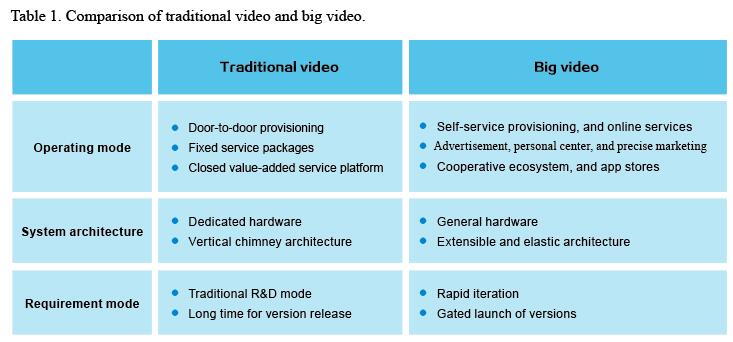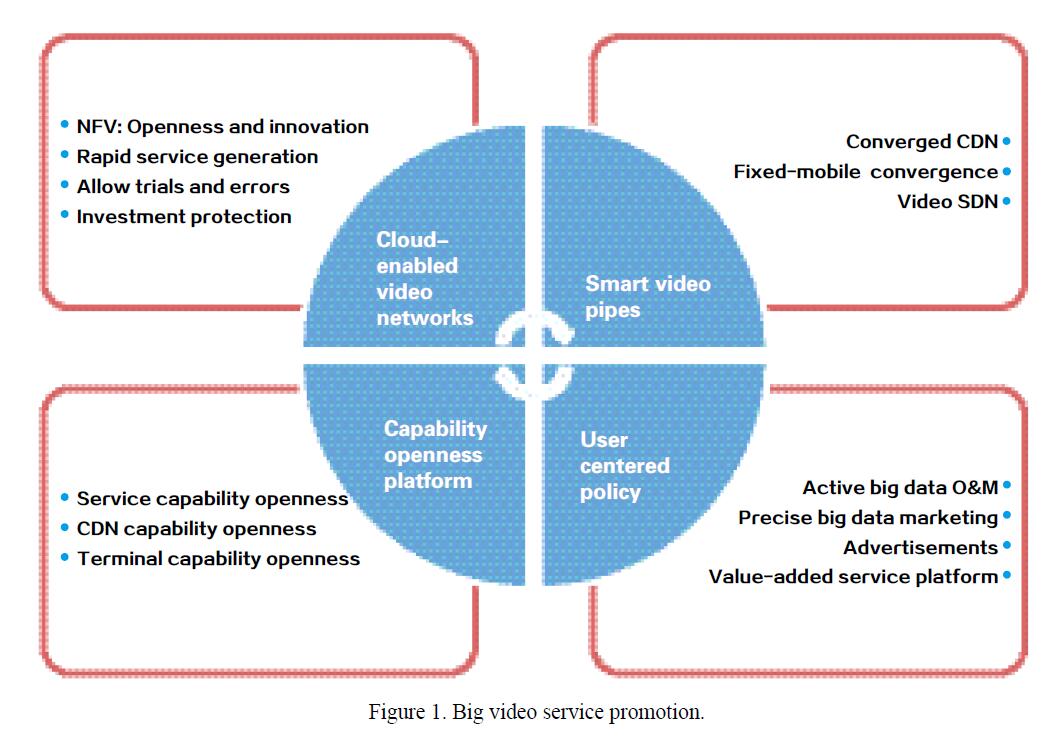The Road to Big Video Revolution
The Advent of Big Video Era
With the evolution of fiber broadband, launch of the 4G network, and popularization of smart terminals, the demand for video services is soaring. People can now download and play videos at anytime and anywhere. Video services have become an important part of our daily life, even a way of life.
Video services will turn into a major business in addition to voice, SMS and data due to its enormous development space and high profitability. As video traffic has increased dramatically, the industry predicts that video services will consume more than 95 percent of data traffic on operator networks in 2020.
The advent of big video era is featured by big content, big network, big data and big eco-system.
● Big content is the core of big video. Various films and television programs are bringing pleasure to our lives. There are mass video contents, including video on demand, live video, video time-shift, video playback, and karaoke, presented in 4K UHD or 8K UHD under different formats. These contents can be played on multiple terminals.
● A big network is the carrier of big video. To meet the strict QoS and QoE requirement and improve user experience, high bandwidth, low delays, low packet loss rate and low costs are required for the bearer network. Moreover, the fixed-mobile converged CDN, SDN and NFV technologies, and the flexible resource scheduling capability ensure a seamless video experience for users.
● Big data embodies the value of big video. The statistics and analysis of big data enables joint operation of cloud, pipe and terminals, and provides excellent services and precise business discovery for customers. Big data helps operators create new business models and value.
● Big ecosystem is the future of big video. No operator can meet all customer requirements. To provide a one-stop service and excellent big video experience for customers, an operator must cooperate with partners inside and outside the industry to achieve win-win situations. To establish an ecosystem, open protocols and technical standards, unified video quality evaluation system, industry integration and participation of all parties are necessities.
As traditional voice services have declined, Chinese government has supported to build broadband networks with many favorable policies. Therefore, operators have attached more and more importance to new data services.
In 2015, with the boom of smart terminals and smart homes, IPTV gradually evolved towards IPTV+, in which various OTT media technologies including HLS are integrated. Video services have extended in many directions, including communication, social media, electronic commerce, and home security and service. An open industry chain has been constructed for the IPTV, and video has developed into a basic service to supplement other services of operators. By formulating comprehensive package, operators attracted subscribers rapidly. For example, the “012” strategy of Sichuan serves as a reference in the field of video services.
Internet video providers, such as Netflix and YouTube, have established their footprint globally in recent years. Meanwhile, traditional telecom operators and TV broadcast operators, through frequently mergers and reorganizations, have provided subscribers with integrated TV video services (IPTV, OTT, and DVB), and specific video services for mobile terminals. Currently, the above operators are boosting their video services with self-built systems or leased systems.
Operators are facing many challenges when they transform traditional video into big video. Table 1 analyzes the differences between traditional video and big video in terms of operating mode, system architecture and demand mode.

How to transfer the closed platform into a big video-oriented platform, how to promote creativity, how to satisfy customers with competitive services, and how to expand user base have become major pain points faced by operators.
To push forward the revolutions of big video, operators must make efforts on cloud-enabled video networks, smart video pipes, capability openness platform and user-centered policy (Figure 1).

Cloud-Enabled Video Networks
The IPTV architecture is tightly coupled to achieve single video services. It not only coupled software with hardware, but also services and data. This architecture is neither in favor of new services deployment, nor conducive to the multi-vendor cooperation in the industry chain.
ZTE considers that the NFV-based cloud architecture is a good choice in the big video era, as it is an open architecture with loose coupling. It separates hardware investment from service development, enables multiple vendors to provide diverse services, and helps operators aggregate a range of services.
Smart Video Pipes
Smart video pipes are used to deploy networks flexibly by integrating fixed and mobile networks. Through multi-screen convergence, the on-demand video services can cover both fixed and mobile network subscribers.
Smart video pipes can be achieved by deploying converged CDN, which supports IPTV, OTT, and cache services. In addition, the converged CDN supports operators’ proprietary services in injected pattern, reduces the cache of inter-network settlement, and improves user experience.
Capability Openness Platform
Big video requires that multiple vendors in the industry chain cooperate in an open capability architecture. Capability openness involves service capability, terminal capability, and CDN capability.
ZTE has developed a cloud-based SOA architecture to build a lightweight big video open service platform. Its flat architecture and rapid iteration mode support the gated launch of version release.
This platform enables a series of service components, including user management, content management, service management, unified authentication, self-registration, payment, messaging, advertisement, bookmarks and favorites, recommendation, and statistics and analysis. By accessing networks, the services invocations are provided to the platform, and unified services are provided on the service discovery layer and service presentation layer.
User-Centered Policy
Good user experience requires that video services should not only be of high quality but also be customized according to customer habits. Therefore, big data technology can be applied to the new generation video network to improve user experience.
With big data technology, the visual O&M system based on equipment operation monitoring and service monitoring can guarantee high quality of video services. The big data operating system, which based on user profile and service analysis to guide service operation, satisfies users’ demands for customized video services.
The development of broadband services and terminal capabilities greatly promotes video services, which by virtue of their interaction, openness, and user-centered policy, have ramifications for the operation of traditional IPTV, OTT, and DVB video services.
Innovations and reforms are implemented in the system network architecture, audio and video transmission and presentation, and video operating mode. In the big video era, these innovations and reforms make new video experience possible for users.